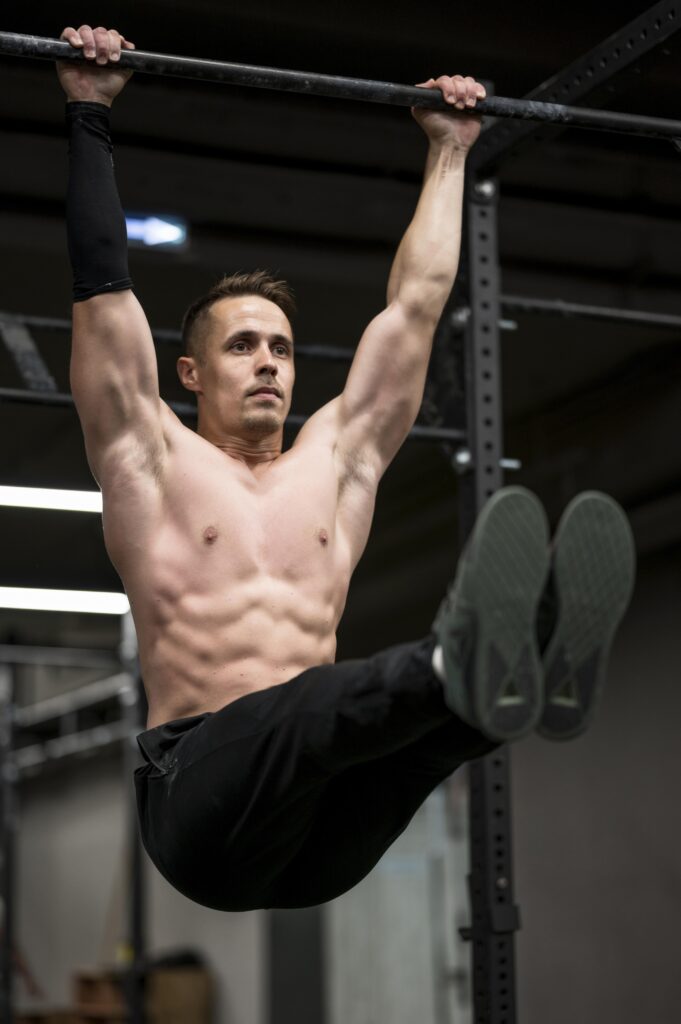Hanging Leg Raises

Credit-Freepik
An exercise you should definitely add in your weekly routine if you’re chasing that defined, V-taper look — the kind of aesthetic physique that turns heads then hanging leg raises should be in your core training routine. This single movement doesn’t just build strength; it carves out your lower abs, sharpens your waistline, and adds serious aesthetic appeal to your midsection.
Unlike basic crunches or sit-ups that mostly target the upper abs, hanging leg raises focus on the lower abdominal muscles, which are often underdeveloped. These are the muscles responsible for that tight, angular look at the base of the six-pack — what many call the “V-cut” or “Adonis belt.” Strengthening these muscles not only enhances visual appeal but also supports better posture, spinal alignment, and athletic performance. But it’s not just about abs.
MuscleBlaze Biozyme Performance Whey Protein
💪 Muscles Worked During Hanging Leg Raises
This exercise is a compound core movement, meaning it activates more than just your abs:
- Rectus abdominis (six-pack abs) – especially the lower portion
- Hip flexors (iliopsoas) – help lift your legs
- Obliques – stabilize your body and assist in controlled movement
- Forearms and grip muscles – engaged while holding onto the bar
- Lats and shoulders – support and stabilize your upper body
By incorporating hanging leg raises into your training, you’re not only building abs — you’re enhancing full-body coordination, grip endurance, and core balance.

How To Do Hanging Leg Raises (Properly)
Getting results from hanging leg raises comes down to form and control. Many beginners make the mistake of swinging or rushing through reps, which defeats the purpose. Here’s a step-by-step guide:
- Grip a pull-up bar with your hands shoulder-width apart. Let your body hang naturally.
- Engage your core by tightening your abs and glutes before initiating any movement.
- Raise your legs slowly until they’re parallel to the ground or higher (aim for a 90° angle).
- Pause for a second at the top of the movement. Focus on squeezing your abs.
- Lower your legs with control, avoiding any swing or momentum.
Beginners can start by bending the knees (knee raises) and progress to straight-leg versions as strength improves.
Key Form Tips:
Don’t swing or use momentum
Keep shoulders pulled slightly down and back
Breathe out while lifting legs; breathe in while lowering
Training Volume & Progression
To make real progress, you need a consistent training plan. Here’s how you can incorporate hanging leg raises into your weekly workout
Sets & Reps:
Beginners:
3 sets of 8–10 reps (bent knees)
Intermediate to Advanced:
3–4 sets of 10–15 reps (straight legs)
Add ankle weights or a dumbbell between feet for more challenge
Progressive Variations:
Hanging knee raises → great for core activation.
Toes to bar → full-range explosive movement.
Leg raises with twist → targets obliques and side abs.
You can also combine hanging leg raises with other ab movements like planks, Russian twists, or reverse crunches for a full core circuit.
Final Thoughts: Why Hanging Leg Raises Make You Look Hotter
Let’s be real — strong abs do more than just improve your health. They add sharpness to your frame, improve how your clothes fit, and boost confidence. Hanging leg raises, when done consistently, help develop that tight, sculpted, greek god look many chase — not just a flat stomach, but visibly defined lines and control.
This exercise brings out the kind of aesthetic changes that show even when you’re standing still — a firmer core, a stronger posture, and that eye-catching V-shape below the abs. Whether you’re training for aesthetics, strength, or function, this move delivers all three.
So next time you’re at the gym, skip the crunches and head to the pull-up bar. Your core — and your mirror reflection — will thank you.
Also Read:
- Imposter Syndrome- Why do you feel you are not ready?
- Men’s Style: 4 Easy Accessories to Elevate Your Look
- The Ultimate Guide for Conquering Dark Circles
- 2 Powerful Gym Exercises for Wide Shoulders
- 10-Minute Cardio: 4 Easy Exercises Anyone Can Do